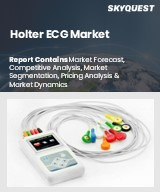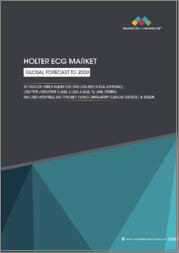
|
시장보고서
상품코드
1789214
홀터 심전도 시장 규모, 점유율, 성장 분석 : 디바이스별, 용도별, 최종 용도별, 리드수별, 지역별 - 산업 예측(2025-2032년)Holter ECG Market Size, Share, and Growth Analysis, By Device (Single-Channel Holter ECG, Two-Channel Holter ECG), By Application (Cardiac Arrhythmia Monitoring, Ischemia Detection), By End Use, By Lead Count, By Region - Industry Forecast 2025-2032 |
||||||
세계의 홀터 심전도 시장 규모는 2023년에 12억 달러로 평가되며, 2024년 13억 달러에서 2032년에는 25억 달러로 성장하며, 예측 기간(2025-2032년)의 CAGR은 8.6%로 성장할 전망입니다.
홀터 심전도 세계 시장은 심혈관 질환의 유병률 증가, 고령화, 예방 의료에 대한 관심 증가 등을 배경으로 성장이 예상됩니다. 홀터 심전도 시스템에 대한 수요는 선진국과 신흥 시장 모두 견고한 편이지만, 지역에 따라서는 기기 비용의 상승과 상환 정책의 미비 등의 문제가 있습니다. 특히 무선통신, 클라우드 기반 데이터 관리, 인공지능 등의 기술 발전은 기기의 사용 편의성과 정확성을 향상시키고, 홀터 심전도의 사용을 병원 환경 외로 확대하는 재택 및 원격 모니터링 솔루션을 촉진하고 있습니다. 북미는 높은 수준의 의료 인프라와 질병에 대한 인식이 높아지면서 시장을 선도하고 있으며, 아시아태평양은 의료시설에 대한 투자와 높은 심장 관련 문제 발생률에 힘입어 큰 성장 잠재력을 보이고 있습니다.
목차
서론
- 조사의 목적
- 조사 범위
- 정의
조사 방법
- 정보 조달
- 2차와 1차 데이터 방법
- 시장 규모 예측
- 시장의 전제조건과 제한
개요
- 세계 시장 전망
- 공급과 수요 동향 분석
- 부문별 기회 분석
시장 역학과 전망
- 시장 개요
- 시장 규모
- 시장 역학
- 촉진요인과 기회
- 억제요인과 과제
- Porter의 산업 분석
주요 시장 인사이트
- 주요 성공 요인
- 경쟁의 정도
- 주요 투자 기회
- 시장 에코시스템
- 시장의 매력 지수(2024년)
- PESTEL 분석
- 거시경제 지표
- 밸류체인 분석
- 가격 분석
- 기술 분석
- 사례 연구
- 고객 구매 행동 분석
홀터 심전도 시장 규모 : 디바이스별, CAGR(2025-2032년)
- 시장 개요
- 싱글 채널 홀터 심전도
- 2 채널 홀터 심전도
- 3 채널 홀터 심전도
- 멀티채널 홀터 심전도
홀터 심전도 시장 규모 : 용도별, CAGR(2025-2032년)
- 시장 개요
- 심장 부정맥 모니터링
- 허혈 탐지
- 심전도(ECG) 모니터링
홀터 심전도 시장 규모 : 최종 용도별, CAGR(2025-2032년)
- 시장 개요
- 병원
- 클리닉
- 외래 수술 센터
- 재택 헬스케어 환경
홀터 심전도 시장 규모 : 리드수별, CAGR(2025-2032년)
- 시장 개요
- 싱글 리드 홀터 심전도
- 2 리드 홀터 심전도
- 3 리드 홀터 심전도
- 4 리드 홀터 심전도
- 멀티리드 홀터 심전도
홀터 심전도 시장 규모 : 지역별, CAGR(2025-2032년)
- 북미
- 미국
- 캐나다
- 유럽
- 독일
- 스페인
- 프랑스
- 영국
- 이탈리아
- 기타 유럽 지역
- 아시아태평양
- 중국
- 인도
- 일본
- 한국
- 기타 아시아태평양
- 라틴아메리카
- 브라질
- 기타 라틴아메리카 지역
- 중동 및 아프리카
- GCC 국가
- 남아프리카공화국
- 기타 중동 및 아프리카
경쟁 정보
- 상위 5사의 비교
- 주요 기업의 시장 포지셔닝(2024년)
- 주요 시장 기업이 채택한 전략
- 최근 시장 동향
- 기업의 시장 점유율 분석(2024년)
- 주요 기업의 기업 개요
- 기업의 상세
- 제품 포트폴리오 분석
- 기업의 부문별 점유율 분석
- 매출의 전년대비 비교(2022-2024년)
주요 기업 개요
- Philips Healthcare(Netherlands)
- GE HealthCare(United States)
- Nihon Kohden Corporation(Japan)
- Bittium Corporation(Finland)
- Schiller AG(Switzerland)
- Medtronic plc(Ireland)
- AliveCor Inc.(United States)
- iRhythm Technologies, Inc.(United States)
- ACS Diagnostics, Inc.(United States)
- Cardiac Insight, Inc.(United States)
- Nasiff Associates, Inc.(United States)
- Mindray Medical International Limited(China)
결론과 제안
KSA 25.08.20Global Holter ECG Market size was valued at USD 1.2 Billion in 2023, poised to grow from USD 1.3 Billion in 2024 to USD 2.5 Billion by 2032, growing at a CAGR of 8.6% in the forecast period (2025-2032).
The global Holter ECG market is poised for growth driven by the rising prevalence of cardiovascular diseases, an aging population, and an increasing focus on preventive healthcare. Demand for Holter ECG systems is robust in both developed and emerging markets, despite challenges such as high device costs and inadequate reimbursement policies in certain regions. Technological advancements, notably in wireless communication, cloud-based data management, and artificial intelligence, are enhancing device usability and accuracy, facilitating at-home and remote monitoring solutions that extend the use of Holter ECG beyond hospital settings. North America leads the market, supported by sophisticated healthcare infrastructures and heightened disease awareness, while the Asia-Pacific region shows significant growth potential, fueled by investments in healthcare facilities and a higher incidence of heart-related issues.
Top-down and bottom-up approaches were used to estimate and validate the size of the Global Holter ECG market and to estimate the size of various other dependent submarkets. The research methodology used to estimate the market size includes the following details: The key players in the market were identified through secondary research, and their market shares in the respective regions were determined through primary and secondary research. This entire procedure includes the study of the annual and financial reports of the top market players and extensive interviews for key insights from industry leaders such as CEOs, VPs, directors, and marketing executives. All percentage shares split, and breakdowns were determined using secondary sources and verified through Primary sources. All possible parameters that affect the markets covered in this research study have been accounted for, viewed in extensive detail, verified through primary research, and analyzed to get the final quantitative and qualitative data.
Global Holter ECG Market Segments Analysis
The global holter ECG market is segmented based on devices, application, end use, lead count, and region. In terms of devices, the market is segmented into single-channel holter ECG, two-channel holter ECG, three-channel holter ECG, and multi-channel holter ECG. Based on applications, the market is segmented into cardiac arrhythmia monitoring, ischemia detection, and electrocardiography (ECG) monitoring. Based on end use, the market is grouped into hospitals, clinics, ambulatory surgery centers, and home healthcare settings. Based on lead count, the market is segmented single-lead holter ECG, two-lead holter ECG, three-lead holter ECG, four-lead holter ECG, and multi-lead holter ECG, Based on Region, the market is segmented into North America, Europe, Asia-Pacific, Latin America and the Middle East and Africa.
Driver of the Global Holter ECG Market
The rise in cardiovascular diseases, including arrhythmias, heart failure, and ischemic heart conditions, is a significant factor driving the growth of the Holter ECG market worldwide. As these health issues become increasingly prevalent, the necessity for continuous and precise cardiac monitoring has intensified. Consequently, there is a growing demand for Holter ECG systems, fueled by an emphasis on early detection and effective long-term management of patients with these conditions. This heightened awareness of cardiovascular health is further propelling innovation and investment in Holter ECG technology, positioning it as an essential tool in modern healthcare for managing heart-related ailments.
Restraints in the Global Holter ECG Market
The Global Holter ECG market faces a significant restraint due to the high costs associated with advanced ECG systems that incorporate sophisticated AI technology and wireless capabilities. These elevated price points pose a barrier to widespread adoption, especially in healthcare systems with constrained budgets, such as those found in low- and middle-income regions. As a result, hospitals and clinics in these areas often opt for more basic and less expensive monitoring solutions rather than the advanced systems, which could enhance patient care. Consequently, the financial burden of these advanced devices restricts their integration into various healthcare settings.
Market Trends of the Global Holter ECG Market
The Global Holter ECG market is experiencing a significant transformation driven by the integration of artificial intelligence into ECG analysis. This technological advancement greatly enhances arrhythmia detection and boosts diagnostic accuracy, allowing for optimal analysis of extensive ECG datasets in a fraction of the time. By reducing clinician workload and supporting more informed clinical decisions, AI-enabled platforms are fostering the development of smarter, more efficient, and automated cardiac monitoring devices. This market trend reflects a broader shift towards automation and sophisticated data analytics in healthcare, ultimately contributing to improved patient outcomes and more effective management of cardiovascular diseases.
Table of Contents
Introduction
- Objectives of the Study
- Scope of the Report
- Definitions
Research Methodology
- Information Procurement
- Secondary & Primary Data Methods
- Market Size Estimation
- Market Assumptions & Limitations
Executive Summary
- Global Market Outlook
- Supply & Demand Trend Analysis
- Segmental Opportunity Analysis
Market Dynamics & Outlook
- Market Overview
- Market Size
- Market Dynamics
- Drivers & Opportunities
- Restraints & Challenges
- Porters Analysis
- Competitive rivalry
- Threat of substitute
- Bargaining power of buyers
- Threat of new entrants
- Bargaining power of suppliers
Key Market Insights
- Key Success Factors
- Degree of Competition
- Top Investment Pockets
- Market Ecosystem
- Market Attractiveness Index, 2024
- PESTEL Analysis
- Macro-Economic Indicators
- Value Chain Analysis
- Pricing Analysis
- Technology Analysis
- Case Studies
- Customer Buying Behavior Analysis
Global Holter ECG Market Size by Device & CAGR (2025-2032)
- Market Overview
- Single-Channel Holter ECG
- Two-Channel Holter ECG
- Three-Channel Holter ECG
- Multi-Channel Holter ECG
Global Holter ECG Market Size by Application & CAGR (2025-2032)
- Market Overview
- Cardiac Arrhythmia Monitoring
- Ischemia Detection
- Electrocardiography (ECG) Monitoring
Global Holter ECG Market Size by End Use & CAGR (2025-2032)
- Market Overview
- Hospitals
- Clinics
- Ambulatory Surgery Centers
- Home Healthcare Settings
Global Holter ECG Market Size by Lead Count & CAGR (2025-2032)
- Market Overview
- Single-Lead Holter ECG
- Two-Lead Holter ECG
- Three-Lead Holter ECG
- Four-Lead Holter ECG
- Multi-Lead Holter ECG
Global Holter ECG Market Size & CAGR (2025-2032)
- North America (Device, Application, End Use, Lead Count)
- US
- Canada
- Europe (Device, Application, End Use, Lead Count)
- Germany
- Spain
- France
- UK
- Italy
- Rest of Europe
- Asia Pacific (Device, Application, End Use, Lead Count)
- China
- India
- Japan
- South Korea
- Rest of Asia-Pacific
- Latin America (Device, Application, End Use, Lead Count)
- Brazil
- Rest of Latin America
- Middle East & Africa (Device, Application, End Use, Lead Count)
- GCC Countries
- South Africa
- Rest of Middle East & Africa
Competitive Intelligence
- Top 5 Player Comparison
- Market Positioning of Key Players, 2024
- Strategies Adopted by Key Market Players
- Recent Developments in the Market
- Company Market Share Analysis, 2024
- Company Profiles of All Key Players
- Company Details
- Product Portfolio Analysis
- Company's Segmental Share Analysis
- Revenue Y-O-Y Comparison (2022-2024)
Key Company Profiles
- Philips Healthcare (Netherlands)
- Company Overview
- Business Segment Overview
- Financial Updates
- Key Developments
- GE HealthCare (United States)
- Company Overview
- Business Segment Overview
- Financial Updates
- Key Developments
- Nihon Kohden Corporation (Japan)
- Company Overview
- Business Segment Overview
- Financial Updates
- Key Developments
- Bittium Corporation (Finland)
- Company Overview
- Business Segment Overview
- Financial Updates
- Key Developments
- Schiller AG (Switzerland)
- Company Overview
- Business Segment Overview
- Financial Updates
- Key Developments
- Medtronic plc (Ireland)
- Company Overview
- Business Segment Overview
- Financial Updates
- Key Developments
- AliveCor Inc. (United States)
- Company Overview
- Business Segment Overview
- Financial Updates
- Key Developments
- iRhythm Technologies, Inc. (United States)
- Company Overview
- Business Segment Overview
- Financial Updates
- Key Developments
- ACS Diagnostics, Inc. (United States)
- Company Overview
- Business Segment Overview
- Financial Updates
- Key Developments
- Cardiac Insight, Inc. (United States)
- Company Overview
- Business Segment Overview
- Financial Updates
- Key Developments
- Nasiff Associates, Inc. (United States)
- Company Overview
- Business Segment Overview
- Financial Updates
- Key Developments
- Mindray Medical International Limited (China)
- Company Overview
- Business Segment Overview
- Financial Updates
- Key Developments













